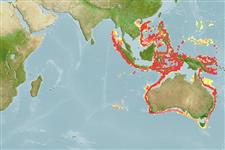Élasmobranches (requins et raies) (sharks and rays) >
Squaliformes (Sleeper and dogfish sharks) >
Squalidae (Dogfish sharks)
Etymology: Squalus: Genus name from Latin 'squalus' meaning shark (Ref. 6885, 27436).
More on author: Whitley.
Environment: milieu / climate zone / depth range / distribution range
Écologie
marin bathydémersal; profondeur 154 - 1370 m (Ref. 58048), usually 383 - 670 m (Ref. 58441). Deep-water
Eastern Indian Ocean to Pacific: warm temperate to tropical waters; Australia to the Philippines; north to Taiwan, including Indonesia.
Taille / Poids / Âge
Maturity: Lm ? range ? - ? cm
Max length : 84.0 cm TL mâle / non sexé; (Ref. 58441); 94.5 cm TL (female)
Description synthétique
Morphologie | Morphométrie
This large species of the ‘mitsukurii group’ is distinguished by the following set of characters: body elongate to robust, trunk depth 8.9-13.4% TL (mean 11.4% TL, n=14); snout is broadly triangular, with mouth width 1.69-2.32 (1.85) times the horizontal prenarial length; pre-first dorsal length 26.5-30.7 (29.0)% TL; pre-second dorsal length 57.6-62.8 (60.8)% TL; interdorsal space 21.7-25.9 (23.7)% TL; low raked dorsal fins; second dorsal-fin length 11.1-13.9 (12.4)% TL, height 3.4-4.6 (4.0)% TL, inner margin length 4.0-5.9 (4.8)% TL; second dorsal-fin base 15.8-21.3 (20.8) times the base of second dorsal spine; pre-pectoral length 20.8-22.9 (22.0)% TL; pelvic-caudal space 22.9-26.0 (24.0)% TL; caudal bar is almost upright, extending broadly from the caudal fork up the poster or margin of the upper lobe for about 0.6 of its length in immature specimens, upper caudal fringe forming a deep saddle along midlength of lobe; flank denticles tricuspid; monospondylous centra 41-47 (mainly 42-44), precaudal centra 79-85, total centra 105-114 (Ref. 58441).
Occurs on or near the bottom of upper continental and insular slopes. Viviparous with yolk-sac dependency; gives birth to 4-16 pups, gestation unknown. Feeds mainly on small fishes, cephalopods, and crustaceans. Usually caught by demersal longline fisheries operating in deepwater. Marketed for its meat, fins, and liver oil which has a high value (Ref. 58048).
Life cycle and mating behavior
Maturité | Reproduction | Frai | Œufs | Fécondité | Larves
Distinct pairing with embrace (Ref. 205).
Last, P.R., W.T. White and H. Motomura, 2007. Description of Squalus chloroculus sp. nov., a new spurdog from southern Australia, and the resurrection of S. montalbani Whitley. p. 55-69. In P.R. Last, W.T. White and J.J. Pogonoski Descriptions of new dogfishes of the genus Squalus (Squaloidea:Squalidae). CSIRO Marine and Atmospheric Research Paper No. 014. 130 p. (Ref. 58441)
Statut dans la liste rouge de l'IUCN (Ref. 130435)
Menace pour l'homme
Harmless
Utilisations par l'homme
Plus d'informations
Taille/ÂgeCroissanceLongueur-poidsLongueur-longueurFréquences de longueursMorphométrieMorphologieLarvesDynamique des populations larvairesRecrutementAbondanceBRUVS
RéférencesAquacultureProfil d'aquacultureSouchesGénétiqueElectrophoresesHéritabilitéPathologiesTraitementNutrientsMass conversion
CollaborateursImagesStamps, Coins Misc.SonsCiguateraVitesseType de nageSurface branchialeOtolithesCerveauxVision
Outils
Articles particuliers
Télécharger en XML
Sources Internet
Estimates based on models
Preferred temperature (Ref.
123201): 6.6 - 11.9, mean 8.6 °C (based on 239 cells).
Phylogenetic diversity index (Ref.
82804): PD
50 = 0.5000 [Uniqueness, from 0.5 = low to 2.0 = high].
Bayesian length-weight: a=0.00339 (0.00162 - 0.00707), b=3.10 (2.93 - 3.27), in cm total length, based on LWR estimates for this Genus-body shape (Ref.
93245).
Niveau trophique (Ref.
69278): 4.4 ±0.4 se; based on size and trophs of closest relatives
Résilience (Ref.
120179): Très faible, temps minimum de doublement de population supérieur à 14 ans (Preliminary K or Fecundity.).
Fishing Vulnerability (Ref.
59153): High vulnerability (58 of 100).
